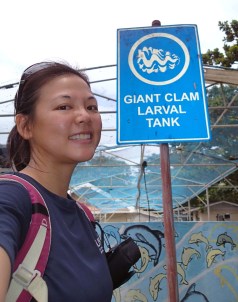 PhD Defense Seminar cum Oral Examination
PhD Defense Seminar cum Oral Examination
“Giant clams (subfamily Tridacninae) in Singapore: Past, Present, and Future“
Neo Mei Lin
Graduate Student
Dept. of Biological Sciences, NUS
Tuesday, 26 Nov 2013: 10.00am
@ DBS Seminar Room 1, S2 Level 4
Supervisor: Asst Prof Peter A. Todd
All are welcome
Abstract:
“Giant clams, the largest bivalve molluscs in the world, are both ecologically and commercially significant across the tropical Indo-Pacific. However, population declines due to exploitation and habitat degradation have been reported throughout their range, including in Singapore. In my study, I made a comprehensive assessment of the giant clams in Singapore, examining key questions that will serve to facilitate conservation of the existing populations and prioritise their protection on Singapore’s reefs.
I first reviewed the ecological roles of giant clams on coral reefs, and explained how they are significant contributors to reef productivity, providers of biomass (for food), calcium carbonate and water filtration, as well as their ability to provide microhabitats to reef organisms and zooxanthellae. I also reviewed their history, research, and conservation in Singapore, and provide evidence that the reefs once supported five species: Hippopus hippopus, Tridacna crocea, T. gigas, T. maxima, and T. squamosa. I next examined the present population status and connectivity of giant clams in Singapore through reef surveys (which covered 87,515 m2 and encompassed 29 sites), population genetics, and dispersal modelling using Delft3D. Only three species (T. crocea, T. maxima, and T. squamosa) were found to be present in Singapore waters, and only in extremely low densities. Analysis of T. crocea and T. squamosa genetic structures showed high genetic diversity but low nucleotide diversity for both populations. Model predictions showed that local and regional connectivity are weak and larval settlement is dependent on the low residual flows that encourage larval retention. Overall, my results suggest that local populations are probably already functionally extinct as they are reproductively isolated (component Allee effects) and are unlikely to fertilise conspecifics.
Additionally, I reassessed and updated the local conservation statuses of the five species known to have been present at some time in Singapore. Finally, I conducted various larvae-based experiments to better understand the early life autecology of the fluted giant clam, T. squamosa. I examined the procedures of spawning inductions and larval rearing, and performed two studies examining the effects of micro-algal diets, and the combined effects of temperature and salinity on the fertilisation success and development of larvae. I also conducted three other studies to close other knowledge gaps in giant clam larval ecology: fertilisation success in relation to gamete age, larval swimming speed, and settlement competency, and then discussed the potential effects and their parameterisation on larval transport predictions. Data arising from these studies will contribute to the enhancement of both mariculture operations and biophysical models. Together, my results provide novel insights into the ecological significance of giant clams on reefs, their history in Singapore waters, their status and connectivity, and their larval ecology, all of which will be important for ongoing conservation efforts.“



![Civet_Portsdown-[GenevieveYeo2013].jpg Civet Portsdown GenevieveYeo2013](https://nusbiodiversity.files.wordpress.com/2013/11/civet_portsdown-genevieveyeo20132.jpg?w=600&h=195)






